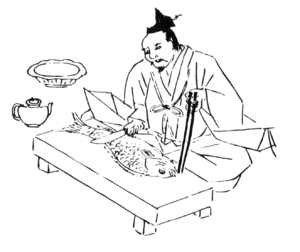Hōchōdō facts for kids
Hōchōdō (pronounced "hoh-choh-doh") is a special Japanese cooking art. Its name means "the way of the cleaver." It's all about preparing fish or birds without touching them with your hands. This ancient skill is also called a knife ceremony (hōchōshiki) or ceremonial knife (shikibōchō). You can still see demonstrations of this unique art today, especially in Kyoto, Japan.
Contents
What is Hōchōdō?
A Sacred Cooking Tradition
Hōchōdō started as a Shinto ritual. Shinto is a traditional Japanese religion. This cooking art was a way to offer food to the gods. It comes from the fancy court cooking style called yūsoku ryōri. This tradition began a very long time ago, during Japan's Heian period. The Heian period lasted from 794 to 1185.
How the Chef Works
When a chef performs Hōchōdō, they use only two tools. They use a special Japanese knife called a hōchō. They also use a pair of metal chopsticks called manabashi. The chef never touches the fish or bird with their bare hands.
The chef wears special clothes from the Heian period. They wear an eboshi hat and a long robe called a hitatare. The hitatare robe has long sleeves. These sleeves are tied up with a string during the ceremony. This makes sure they don't get in the way while the chef is working.
Different Schools of Hōchōdō
There are different styles, or "schools," of Hōchōdō. Each school has its own special ways of doing things.
Shijō School
The oldest school is called the Shijō school (Shijō-ryū). Its name means "Fourth Street school." This style was started by a person named Fujiwara no Yamakage. He lived in the early Heian period, around the 9th century. He was also known as "Fourth Street middle counselor." This was because he built a big house near Shijō Street in Kyoto. That's how the school got its name.
Ikama School
Today, the most well-known school is the Ikama school (Ikama-ryū). The current leader of this school is Shigeyoshi Konishi. He is the 29th generation leader! His special art name is Masayasu Ikama. He works at a restaurant in Kyoto called Mankamerō.
The Ikama school started in the early Kamakura period. This was around the late 12th century. It began in the homes of samurai warriors. The emperor had given these families the special "Ikama" name. In this school, the art is often called shikibōchō. That's why this name is commonly used today.
Where to See Hōchōdō
Sometimes, Hōchōdō rituals are performed at Shinto shrines. These are special offerings to the gods. They don't happen on a regular schedule. If you want to see a private show, you can arrange one with the chefs.
The biggest event for Hōchōdō is the Kyoto cuisine exhibition. This event happens every year in December in Kyoto. Many chefs show off their skills there. It's a great chance to see this amazing traditional art form.



